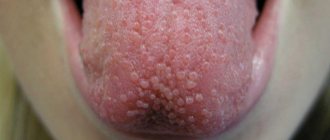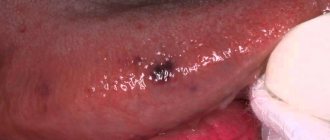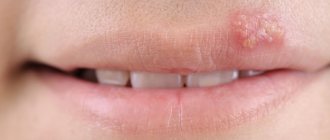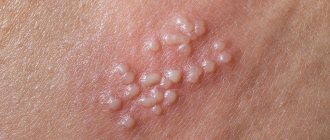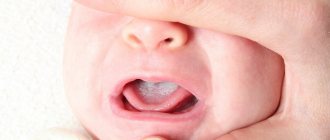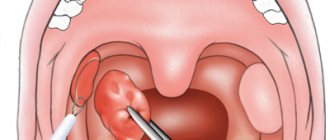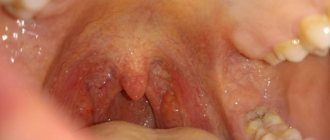Petechiae are tiny, round spots that appear on the skin, mucous membrane, or serous membrane. They occur as a result of bleeding under the skin.
Typically, petechiae appear on the surface of the skin, eyelids, or oral mucosa.
Some causes of petechiae do not require special treatment, while others may be more serious.
Petechiae usually look like a rash. The appearance of petechiae can be caused by many different reasons. It is advisable to make an appointment with a doctor if petechiae appear.
| The article was verified by medical expert Lyubov Vasilievna Maslikhova |
What are petechiae? How do they look?
Petechiae look like a rash, only more pronounced and scary. The spots themselves are tiny patterns that can be purple, red or brown, which is associated with bleeding under the skin.
They are usually flat to the touch and, unlike rashes, will not discolor when pressed - this is a useful way to tell whether any skin abnormality is a rash or not.
Petechiae - photo
Causes of petechiae
Petechiae occur when tiny blood vessels (capillaries) burst. When this happens, blood leaks under the skin.
Some of the reasons that can lead to petechiae include:
- local trauma or trauma in which the skin is damaged;
- sunburn;
- allergic reactions to insect bites;
- various autoimmune diseases;
- viral and bacterial infections;
- decreased level of platelets in the blood;
- medical treatments for cancer, such as radiation or chemotherapy;
- leukemia or bone marrow cancer, which leads to a reduction in platelets;
- after severe vomiting or coughing - especially in newborns;
- strenuous activity, such as heavy lifting or childbirth;
- sepsis;
- scurvy;
- vasculitis;
- viral diseases such as dengue fever, ebola and yellow fever can interfere with blood clotting, causing bleeding under the skin.
The use of certain medications can also cause petechiae. Drugs that can cause petechiae as a side effect:
- antibiotics;
- antidepressants;
- contraceptives;
- blood thinners;
- drugs to normalize heart rhythm;
- non-steroidal anti-inflammatory drugs (NSAIDs);
- sedatives.
If petechiae appear after taking any medications, you should consult a doctor.
Causes of hematoma formation on the oral mucosa
The general scheme of hematoma formation is as follows: a rupture of a vessel causes the leakage of a certain amount of blood, followed by its compaction and the appearance of a blood clot. A bubble forms, noticeable on the smooth surface of the mucosa due to its dark coloring and relief. Often a similar picture can be observed during teething, when the gums bleed and become inflamed. The formation of multiple small hematomas, covering the entire surface of the mucous membrane in the mouth with unattractive dark spots, looks very unpleasant for the patient. But don’t panic if you suspect you have a serious illness. As practice shows, most of these phenomena occur due to mechanical trauma to the mucous membrane. But there are exceptions when the symptom indicates:
- allergic reaction;
- chronic injury;
- consequences of stressful situations;
- burns or cuts to the mucous membrane.
There have also been cases when multiple hematomas in the oral cavity are signs of:
- diabetes mellitus;
- hypertension;
- renal failure;
- complex types of stomatitis;
- blood diseases;
- vitamin deficiency, which causes fragility of blood vessels.
The exact cause and stage of formation of the pathology can only be determined after a thorough examination and diagnosis. For this reason, you should not self-medicate, so as not to further injure damaged tissues.
Petechiae in a child
Petechiae in children mainly occur due to trauma. Children often play actively and bruises, abrasions and bruises are normal. Petechiae on the skin of children is usually caused by trauma.
Petechiae in a child can also occur in the mouth. Petechiae on the mucous membrane of the mouth and palate may appear in a child due to solid food that has damaged the mucous membrane. However, petechiae on the oral mucosa can also occur as a result of malnutrition, lack of vitamin K, and childhood scurvy.
Septicemia can also cause petechiae in a child. More often, septicemia occurs in young children, since their immune system is not yet fully formed and is not fully capable of fighting pathogens. Septicemia can accompany any disease; it is an infection of the blood by bacteria. This condition is accompanied by the rapid spread of a rash on the child’s skin; the child’s petechiae spots do not change color when pressed on them. Septicemia progresses rapidly, fainting is typical, and the child may become delirious.
If you suspect septicemia, you must immediately consult a doctor as soon as possible, the child’s life depends on it!
However, in most cases, petechiae in children are the result of trauma.
Inflammation of the oral mucosa and stomatitis
What is stomatitis and other lesions of the oral mucosa? Oral irritations and lesions are swellings, rashes or sores in the mouth, lips or tongue. Although there are different types of oral lesions and diseases, some of the most common are stomatitis, herpes, leukoplakia and candidiasis (thrush).
What is inflammation of the oral mucosa and its other lesions? Oral irritations and lesions are swellings, rashes or sores in the mouth, lips or tongue. Although there are different types of oral lesions and diseases, some of the most common are stomatitis, herpes, leukoplakia and candidiasis (thrush). We will talk about them below. If you have oral lesions, you are not alone - approximately a third of all people experience similar problems. However, lesions in the oral cavity, inflammation of the mucous membrane and wounds on it can be painful, unpleasant in appearance and interfere with normal eating and speaking. Any lesion in the oral mucosa that does not go away within a week or longer should be seen by a dentist. You may be advised to undergo a biopsy (tissue collection for research), which can usually determine the cause of the disease and rule out the possibility of serious diseases such as cancer and HIV.
How do I know if I have stomatitis or other damage to the oral mucosa? The following signs may indicate stomatitis and other lesions of the oral mucosa:
- Stomatitis is small white sores surrounded by redness. Although stomatitis is not contagious, it is often confused with rashes that are caused by the herpes virus. It should be remembered that stomatitis manifests itself inside the oral cavity, and herpetic rashes usually appear outside. Stomatitis may recur from time to time. It can be mild (small rashes), severe (large rashes) or herpes-like (groups or clusters of numerous rashes).
- Stomatitis is a common disease, and it often recurs. Although the exact cause is unknown, dentists believe it may be due to a weakened immune system or exposure to bacteria or viruses. In addition, factors such as stress, injury, allergies, cigarette smoking, iron deficiency or vitamin deficiency, and heredity may play a role.
- The rash, also called cold sores or herpes simplex, is a group of painful, fluid-filled blisters located around the lips and sometimes under the nose or around the chin. Cold rashes are usually caused by a type of herpes virus and are highly contagious. Herpes infection often occurs in childhood; sometimes it is asymptomatic and can be confused with a cold or flu. After infection, the virus remains in the body, carrying out repeated attacks from time to time. However, in some people the virus is not active.
- Leukoplakia appears as thickened, whitish plaques on the inside of the cheeks, gums, or tongue. It is often associated with smoking and the use of smokeless tobacco, although it can also be caused by poorly fitting dentures, broken teeth, and chewing on one side of the jaw. Since an estimated 5% of leukoplakia cases develop into cancer*, your dentist may perform a biopsy. Often leukoplakia is cured after quitting tobacco.
- Candidiasis (oral thrush) is a fungal infection caused by the fungus candida albicans. The symptom of the disease is creamy, yellowish-white or red plaques on the lining of the mouth. Plaques can be painful. Thrush most often occurs in people who develop dry mouth for various reasons or who are or have recently been treated with antibiotics. The risk group includes people wearing dentures, newborns, patients weakened by diseases, as well as those with a weakened immune system.
How are inflammation of the oral mucosa and other lesions treated? Treatment depends on the type of disease. Most of the typical disorders and lesions of the oral mucosa described above are treated as follows:
- Stomatitis - Stomatitis usually goes away in 7-10 days, although repeated relapses of the disease are possible. Over-the-counter ointments and pain relievers may provide temporary relief. Rinsing with an antibacterial mouthwash can reduce inflammation and pain. In some severe and persistent cases, doctors prescribe antibiotics to suppress the activity of the bacteria that caused the disease. In any case, if signs of stomatitis occur, immediately contact your dentist in order to promptly diagnose the disease and begin proper treatment.
- Herpetic rashes - If a characteristic herpetic rash appears, contact your dentist immediately. The blisters usually heal in about a week. Since herpes infections cannot be cured completely, rashes may reappear during nervous shock, sun exposure, allergies or the flu. Over-the-counter local anesthetics may provide temporary relief. Prescription antiviral medications can help treat these types of viral infections.
- Leukoplakia - Consultation with a doctor is required. The main treatment is aimed at combating the factors that cause leukoplakia. For some patients, this means quitting tobacco. For others, this means replacing dentures with ones that better fit their jaws. Your dentist will monitor your condition, examining you at intervals of 3 to 6 months, depending on the type, location and size of the lesions.
- Candidiasis is a serious disease that requires diagnosis and consultation with a dentist. Prevention of fungal infection is to avoid situations that lead to the disease.
- The main cause of the disease is often antibiotic therapy or oral contraceptives. In these cases, reducing the dose or changing the drug can help avoid the development of the disease.
- To avoid any problems with dentures, they need to be cleaned. You should also remove dentures at night.
- Saliva substitutes can help with dry mouth.
- In some cases, after examination by a dentist, it becomes necessary to prescribe antifungal drugs that suppress the activity of the fungi that caused the disease.
- Careful oral hygiene is required.
| Cold blisters | Stomatitis |
*Complete guide to dental care. – Jeffrey F. Taintor, DDS, MS, and Mary Jane Taintor, 1997
When should you see a doctor?
It is highly advisable to have your doctor examine petechiae on the skin and mucous membranes because they may be a sign of a more serious condition. The doctor will evaluate the symptoms and possible causes to determine whether the cause of the petechiae is mild or severe.
If the number of petechiae continues to increase, bleeding may be the cause.
There are also other symptoms that may occur along with petechiae, which are indicators of a severe or life-threatening condition.
These include:
- loss of consciousness;
- confusion;
- heat;
- heavy bleeding;
- Strong headache.
If any of these symptoms occur along with the appearance of petechiae, a person should seek immediate medical attention. Petechiae on the skin and mucous membranes plus the above symptoms are an alarming signal.
Treatment
Treatment for petechiae will depend on the underlying cause. If the petechiae are caused by a reaction to a specific drug, they will disappear as soon as you stop taking the drug.
If the cause is a viral or bacterial infection, they should go away once the infection is cleared.
The doctor will diagnose the cause of the petechiae and recommend appropriate treatment.
Drug treatment of petechiae
The doctor may prescribe:
- antibiotics to treat a bacterial infection;
- corticosteroids to reduce inflammation;
- Azathioprine, Methotrexate or Cyclophosphamide may be prescribed for the treatment of autoimmune diseases;
- for the treatment of cancer - chemotherapy, biological therapy.
If the appearance of petechiae is not a consequence of an underlying condition, then rest, drinking plenty of fluids and painkillers may help:
- Ibuprofen;
- Acetaminophen;
- Tylenol.
Petechiae on the skin due to injury do not pose any danger. They can be treated with a forehead remedy that treats bruises. Petechiae on the oral mucosa caused by eating solid foods will go away on their own over time.
Are there any complications?
The appearance of petechiae does not have any complications. In most cases, petechiae on the skin disappear without a trace, when the petechial rash disappears - it does not leave scars.
However, if petechiae on the skin and mucous membranes are the result of an underlying disease, some complications may occur.
Complications include:
- damage to the kidneys, liver, spleen, heart, lungs or other organs;
- various heart problems;
- infections that may occur in other parts of the body.
What to do to avoid oral complications
If you have been diagnosed with coronavirus infection and are experiencing complications in the oral cavity, contact your doctor to get permission to visit the dentist. When making an appointment with a dentist, be sure to tell them: you are or have been sick with Covid-19. The dentistry of the ElitDental M clinic will help alleviate the symptoms of the disease in the oral cavity and provide comprehensive treatment. We are located at:
- Rostov-on-Don, st. Zhdanova 3. Make an appointment by phone, +7(863) 544-63-54.
- Rostov-on-Don, Mironova street 6. Make an appointment by phone.
Opening hours: Monday – Friday from 9.00 to 20.00. Saturday from 10.00 to 17.00. Sunday is a day off.

